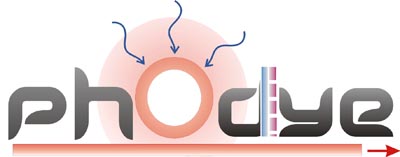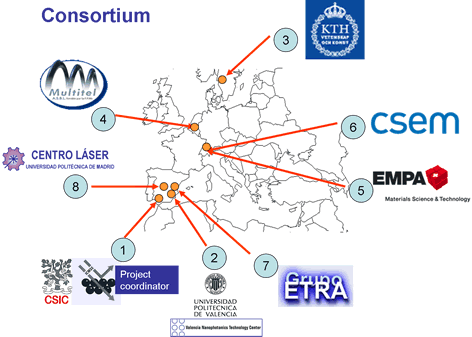PHODYE – photonic chips with solid dye film
New PHOtonic Systems on a Chip based on DYEs for Sensor Applications scalable at Wafer Fabrication.
2006–2010
PHODYE is a multidisciplinary project that aims to develop a new sensing and recognition technology based on the integration of dye thin films with photonic structures. The devices developed will yield a distinct optical response according to changes in the environment that can easily be measured by a photonic chip or recognized directly by the human eye.
The dye thin films are prepared by a new plasma polymerization procedure that is fully compatible with the integrated optoelectronic technology. The dye molecules in the films react to changes in the concentration of certain gases and/or in temperature or UV radiation by a change of their absorption/fluorescence properties.
By the use of photonic resonant structures an enhancement of the dye response is obtained achieving sensitivities below 10 ppm (NO2 detection) with a response time lower than 2 minutes. A key feature of the project is to achieve an effective optical coupling between the photonic structures and the film fluorescence/absorption response, so that changes in this latter can be transformed into proportional photonic signals or visible colour shifts.

A technological objective of PHODYE is the integration of more than one sensing element into a chip based on ring resonators that would be capable of monitoring simultaneously various gases/physical parameters.
A second technological objective is the construction of recognition chips that upon light excitation have a predetermined fluorescence response which changes depending on a given physical or chemical parameter. As the optical structures have dimensions of the order of 100 nm, the sensor response should be very fast. Such devices could be used as stand-alone, disposable low cost sensors.
Devices based on photonic resonant structures can be easily integrated into measurement devices, communication networks etc. Their low cost and their compatibility to dangerous environments where electricity cannot be used make them a unique solution for a wide range of application areas (homes, hospitals, industry, explosives, traffic, etc.).
Project partners

CSIC-ICMS, Instituto de Ciencia de Materiales de Sevilla
UPVLC-NTC, Universidad Politécnica Valencia, Centro Tec. Nanofotónica
MULTITEL, Applied Photonics Department, Brussels
Project members
Martin Lapisa
Mikael Antelius
Project Sponsor
- European commission, 6th framework programme
